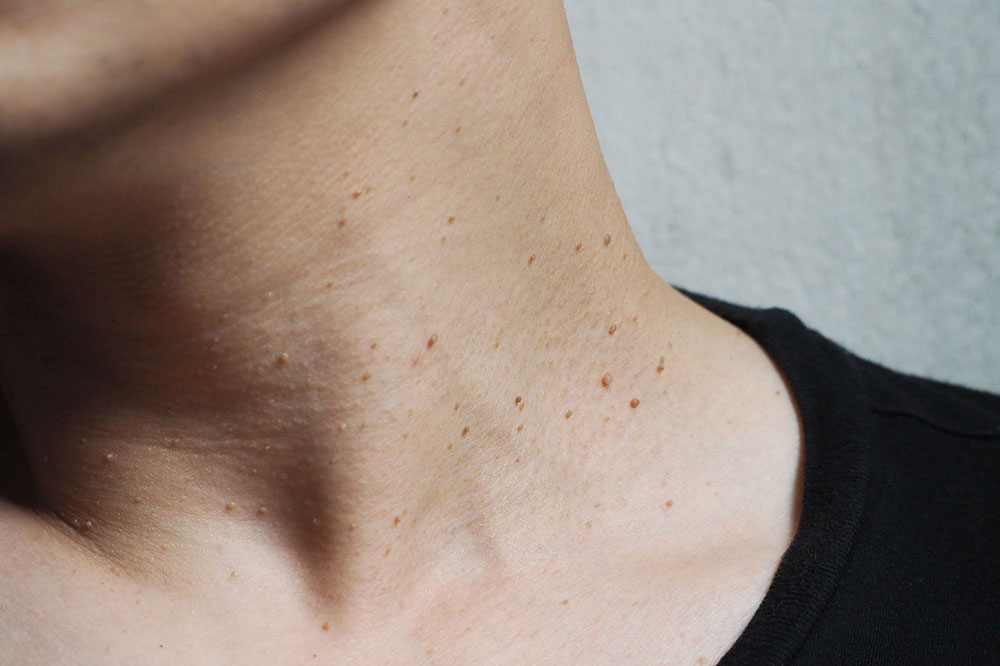
Causes, symptoms, and management of acrochordons (skin tag)
Small, benign growths known as acrochordons usually have the same color as the skin epidermis. They frequently resemble a mass of skin tissue growing from a small stem. They can occasionally be darker and mimic a raised mole. Most skin tags range from 1-5 millimeters, but some can reach a few centimeters. They may cause discomfort if they are on your forehead or neck. A medical professional’s skin tag removal technique may be helpful.
Cause of acrochordons
Acrochordons are widespread; according to research, half of all people will experience at least one skin tag throughout their lifetime. Although individual health remains unaffected by a skin tag, they may be unappealing. Acrochordons develop when the body creates extra cells in the outermost layers of the epidermis. They frequently develop in skin creases and places where the skin rubs up against itself naturally during movement. The tags commonly appear in the following:
- Underarms
- Eyelids
- Legs or the groin
- Neck
- Within the breasts
- Genitals
As you get older, skin scars are more likely to appear. It will be worrying if you have the following causes for acrochordons:
- Have a history of facial tags in your family
- Live with conditions like Birt-Hogg-Dubé syndrome, diabetes, obesity, or other skin conditions
- Elevated growth factor levels, which are possible during pregnancy
Signs and symptoms associated with acrochordons
Acrochordons rarely produce symptoms but can be irritating or ugly, especially if they’re in a conspicuous location or rubbed against jewelry or clothing. They could sporadically get red, puffy, or inflamed if repeatedly irritated or wounded.
Several acrochordons can occur in some persons, especially as they age or are overweight. Acrochordons may, in rare instances, be a symptom of an underlying medical issue, such as hereditary disorders or insulin resistance.
Diagnosis for acrochordons
It’s crucial to visit a healthcare professional for additional assessment and treatment if you detect any odd changes in the appearance or amount of skin tags or if they start to hurt or itch. Acrochordons are typically simple to remove by minor surgery or cauterization.
- Inquiries about your medical history will be carefully screened for conditions that increase your chance of developing skin tags. A brief examination helps exclude growths that might resemble skin tags.
- Skin tag diagnosis is confirmed without the need for investigations. Your healthcare provider may take a biopsy (sample) and send it to the lab for further analysis if they suspect any complications.
Recommended treatment plans
Your skin tag might not require treatment if it doesn’t hurt and you’re not bothered by how it appears. The majority of skin tags don’t even require therapy. Some people might leave on their own. Dermatologists are qualified and trained to handle sensitive issues, such as skin tags on eyelids or necks. Moreover, doctors are skilled at correctly identifying growths other than skin tags. For example, you may want to discuss skin tag removal with your doctor. The following methods of treatment may be used during a clinic visit:
- Use a sharp tool like a scalpel to shave or cut it off
- To freeze it, use a very frigid gas (liquid nitrogen)
- Heat (cauterization) to halt the bleeding or burn it off
The treated region will probably start to scab over in the days following the procedure. You might see minor skin flaws after the scab breaks off, but nobody else will likely spot them.
Steps to be followed to prevent acrochordons
Skin tags, or acrochordons, are typically not harmful and cannot always be avoided. Yet there are certain things you can do to lessen your chance of getting new skin tags:
- Maintaining a healthy weight: Skin tags are more likely to grow in regions where skin scrapes against the skin when overweight or obese.
- Maintain dry, clean skin : Moist body parts, such as the groin and armpits, are more prone to developing skin tags. Skin tags can be prevented by maintaining these areas’ cleanliness and dryness.
- Avoid wearing tight clothing: It can cause friction and make skin tags more likely to appear, especially when the skin rubs against the garment.
- Manage underlying medical issues: Insulin resistance and hormonal imbalances are two diseases that can make you more likely to get skin tags. Skin tags may be avoided by treating these ailments with medication and lifestyle modifications.
- Consider removal of existing skin tags: Take into account removing skin tags that are already present; doing so can assist in stopping new ones from appearing in the same location.
Keep a healthy routine
The likelihood that you’ll develop acrochordons during your lifespan is high. Skin tags may be unsightly, but they are not cancerous and shouldn’t be a reason for alarm. You can have them removed if the way they look bothers you or if they rub against your flesh, jewelry, or clothing. The risk of problems and scarring is reduced when a skilled healthcare professional removes skin tags.




